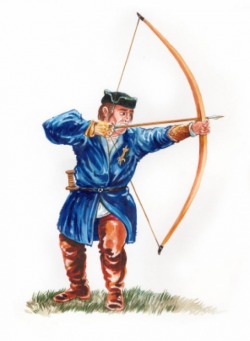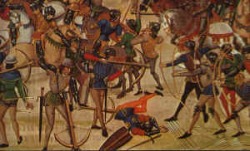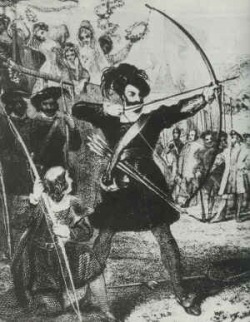The discovery of the first stone arrowheads in Africa tends to indicate that the bow and arrow were invented there, maybe as early as 50,000 BC.
It was probably developed in conjunction with the invention of the spear thrower.
A short bow would be a better hunting weapon when used to stalk animals in wooded areas, rather than carry around long spears.
The shape of the earliest bows can only be guessed at, as broken or worn out bows would probably end up on the cooking fire, reshaped into different tools or just thrown away.
Since man first created weapons with which to hunt for food and wage war, target competitions have become part of human culture. Just as competitive genetics make people want to run faster, throw longer and jump higher than anyone else, so to do they want to prove their ability to aim more accurately and shoot straighter than anyone else.
Historians suspect that the use of primitive bows and arrows – one of man’s first mechanical inventions – could date back as far as Stone Age man in 20,000BC. They know for sure, however, that archery was widely used by the armies of many of the classic ancient civilizations that inhabited Europe and the Middle-East around 5000 years ago.
Although the archers weren’t always the mainstay of an army, they were an important part of a nation’s military might, and the ancient Egyptians, Greeks, Hittites, Assyrians and Chinese all used archery as a weapon of combat to great effect, with the very best archers celebrated and acclaimed as great warriors and heroes.
In the Middle Ages, archery was widely used in wars across Europe, but as the properties of gunpowder became more widely known from China through Asia and the Middle East to Europe, archery’s effectiveness in combat and hunting became less and less significant.
It remained a popular pastime, though, particularly with royalty and nobility, though and in the middle of the 16th century, the first clubs and competitions began to spring up in England. King Henry VIII founded the first archery club in England – the Brotherhood of St George – in 1537, while the first recognised formal archery competition took place in Finsbury, England, in 1583, with over 3000 participants turning up to test their aim.
Up until the present day, archery has remained a popular sport – a popularity that has increased significantly since it joined the Olympic schedule in 1900.
Archery was a sporadic part of the modern Olympic schedule through the early 1900s, with events in the 1900, 1904, 1908 and 1920 Summer Games. In archery’s early years, competitors were allowed to compete in a more than one event, allowing them to win a multitude of medals. One of the best was Belgian Hubert Van Innis, who won six golds and nine archery medals in total in both team and individual competitions.
After a hiatus of 52 years, archery returned to take a full-time place in the rosta of Summer Games sports in Munich, Germany, in 1972. Team archery for three-strong squads was added to the events list for the 1988 Summer Games in Seoul, South Korea.
One of the best archers of recent times is South Korean Soo-Nyung Kim, who wowed the crowds at her home Olympics in 1988 by scoring gold in both the women’s individual and team events at the age of 17. After another individual gold medal-winning performance in Barcelona, Spain, in 1992 she retired from the sport at the age of 21, but returned to Olympic competition in Sydney, Australia, in 2000 to win a fourth gold in the team event.
The Battle of Hastings was the decisive Norman victory in the Norman conquest of England. The location was a hill approximately six miles north of Hastings, on which an abbey was subsequently erected.
The battle took place on October 14, 1066, between the Norman army of Duke William of Normandy, and the Saxon army led by King Harold II. Harold was killed in the battle; traditionally, it is believed he was shot through the eye with an arrow. Although there was further Saxon resistance for some time to come, this battle is seen as the point at which William gained control of England.
The English Longbow
The English longbow, also called the Welsh longbow, was a powerful type of medieval longbow (a tall bow for archery) about 2.0 m (6 ft 6 in) long used by the English and Welsh, both for hunting and as a weapon of war. English use of longbows was effective against the French during the Hundred Years' War, particularly at the start of the war in the battles of Crecy (1346) and Poitiers (1356), and most famously at the Battle of Agincourt (1415).
The Battle of Agincourt (IPA pronunciation: [/ɑːʒɪn'kuːʁ/]) was fought on 25 October 1415 (Saint Crispin's Day), in northern France as part of the Hundred Years' War.
The armies involved were those of the English King Henry V and Charles VI of France. Charles did not command his army himself, as he was incapacitated. The French were commanded by the Constable Charles d'Albret and various prominent French noblemen of the Armagnac party. The battle is notable for the use of the English longbow, which the English used in very large numbers, with longbowmen forming the vast majority of their army. The battle was also immortalised by William Shakespeare as the centrepiece of his play Henry V.
Image: A period illustration of the Battle of Crécy. English longbowmen figure prominently in the foreground at right where they drive away the French crossbowmen.

Paragraph.




